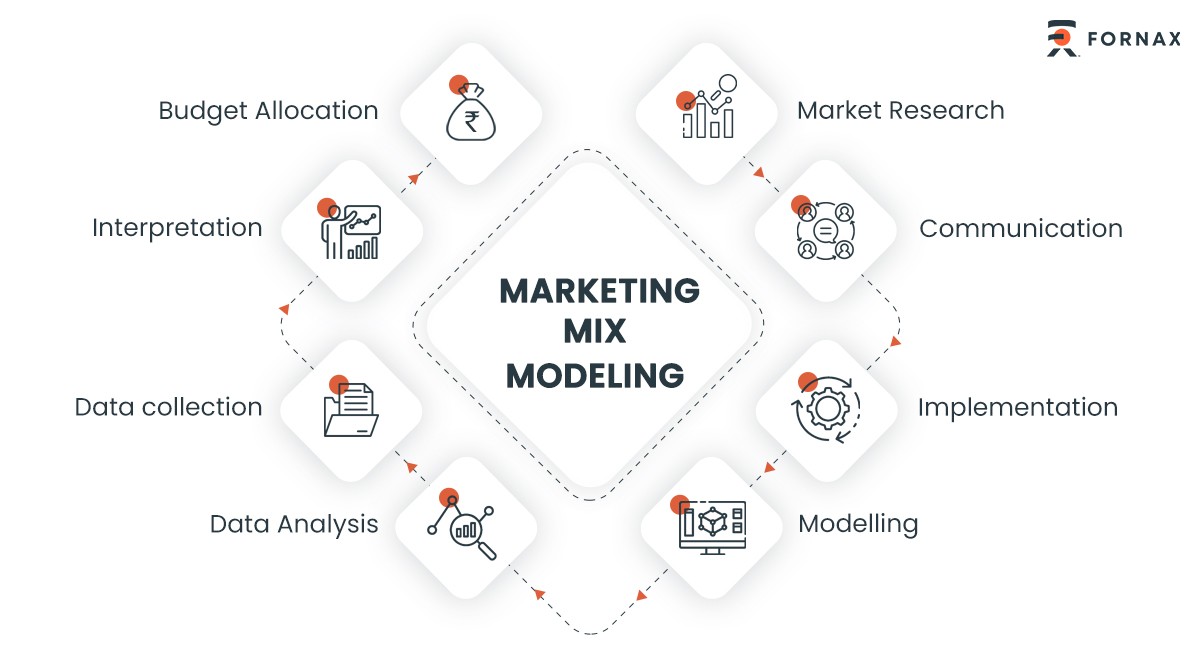Understanding Marketing Mix Modeling and How to Apply in Business

Businesses find it challenging to gauge the efficacy of their marketing in today's cutthroat marketing environment. It can be difficult for most businesses to predict the long-term effects of changing marketing KPIs and to optimise boosting sales and profitability for customer segments. We can measure the effectiveness of the marketing mix on Key Performance Indicators via marketing mix modelling (KPIs). Typical KPIs include financial metrics like revenue and profitability as well as customer activities like sales and churn while lowering the cost of acquiring each new customer.
By analysing aggregate data, modelling mix enables you to assess the success of your marketing initiatives. This strategy makes decisions based on evidence rather than just past performance and gut feeling. It is a component of a more significant movement that includes data science and digital analytics.
How to define marketing mix modelling?
Over the past few decades, Marketing Mix Modeling (MMM) has proven to be a vital tool for businesses looking to optimise budget distribution to various media types, including digital channels, television, print, radio, etc.
The MMM method aids in calculating the effect of various marketing inputs on sales or market share. Understanding how much each marketing input adds to sales and how much to invest in each marketing input are the goals of MMM. Additionally, it is employed in budget optimization for these many marketing inputs.
- Product
Businesses need to comprehend the problem that their product or service is trying to solve in order to design it appropriately. The product's potential profitability should be reevaluated if it doesn't appear to solve any problems. It's also important to identify the target market or the people who will purchase the goods.
- Price
Price has a direct bearing on how well a product will sell and is related to the consumer's perception of the product's value. In other words, the price has nothing to do with how much the company values the product. Therefore, it's critical to understand what the consumer values and set prices accordingly.
- Promotion
Advertising, sales promotions, and public relations are all examples of marketing communication tactics that fall under the heading of promotion. Regardless of the channel, communication needs to be appropriate for the product, target market, and pricing.
- Place
Place refers to the actual location where a client can use, access, or buy the finished good.
The location of a buyer's search may seem straightforward, but it has repercussions for marketing and product development.
Additional components of a successful marketing mix
Traditional marketing strategies focus on products, but many companies also offer services and other intangible items.
- People
The term "people" refers to the employees who are both, directly and indirectly, involved in brand marketing.
- Process
The process is crucial since customers frequently provide feedback on a company's service, allowing the company to enhance all of its processes.
- Physical Evidence
Anything that customers observe when interacting with a brand is referred to as physical evidence. Packaging, branding and even the structural layout of shop premises can serve as tangible proof.
How does a marketing mix model work?
You are building a streamlined representation of reality with marketing mix modelling. Based on what you believe might be affecting your sales, you use data from the numerous activities you have undertaken. From there, you construct an equation that will aid in connecting those relationships.
A marketing mix model is a numerical instrument that aids companies in comprehending how adjustments to their marketing initiatives (such as pricing, product, promotion, and place) affect their revenue and earnings. Four steps can be taken to build such a model:
- Decide what corporate goals the Mix Model will help you achieve.
- Gather information about previous marketing initiatives and sales. Collecting outside information, such as weather reports, is another choice.
- Create a mathematical model that connects marketing initiatives to sales using the data after it has been prepared.
- Choose the right mix of marketing initiatives to increase the company's earnings.

Factors affecting the marketing mix model:
- Finances: How much money will be spent on marketing should be taken into account by the company.
- Market demands: As a company expands, it should keep conducting market research since consumer demands vary over time.
- Competitor: As a result of rival activity in the market, the marketing mix of competitors may be sued.
- Technology: The location of where items are purchased and sold may shift as a result of developments in technology, such as the internet.
- Demand: Demand is impacted by price since their relationships are inverse.
- Nature: Affected by appearance or evidence
Benefits of Modeling the Marketing Mix For Business:
- Allows marketers to demonstrate the effectiveness of their work across all marketing platforms.
- Provides information that enables efficient budget allocation.
- Enables more accurate sales trend forecasting
4 Phases of Marketing Mix
Each marketing strategy is assessed by MMM for its impact to sales, effectiveness, efficiency, and ROI. These findings can be used by marketers to design data-driven marketing strategies, enhance the marketing mix, and project future sales.
A MMM process typically consists of four parts:
1. Data Collection
Access to previous data from your marketing efforts, non-marketing sources, and information on outside circumstances is necessary for MMM. If you continue to rely on third-party cookies for some of this data, you must switch your attention to first-party data collecting in order to monitor how consumers are responding to your marketing mix.
2. Modeling
Online channels perform better with MMM than difficult-to-measure conventional techniques like broadcast and print. MMM can provide you with an exact ROI and quick, reliable information for decision-making if your primary investments are in digital marketing.
3. Data Insights & Analysis
Once a sound model is in place, analysis and insight-finding can be done.
Analyze each channel's contribution to the desired outcome you set out to explain first. In this instance, you will be able to rate your marketing initiatives based on how they affected your sales. You may calculate media efficacy, efficiency, and ROI from there.
4. Optimization
Utilizing your findings to improve your marketing mix going forward is the final stage of marketing mix modelling. You can identify the appropriate mix of strategies for achieving your income targets by doing simulation exercises or What-if Analyses.
MMM Drivers for Input:
Base Drivers:
Different sales factors, such as price, distribution, seasonality, macroeconomic variables, brand affinity, etc., play a crucial role in understanding consumer behaviour toward products in order to construct a strong and stable market mix model.
- Price: A key base driver of sales is a product's price since it influences both the consumer group to that a product is marketed and the promotional strategies that are used to reach that group.
- Distribution: The number of retail outlets, their individual inventories, and the stock's shelf life are all taken into account as the primary drivers of sales.
- Seasonality: Seasonal opportunities abound and frequently coincide with the most crucial commercial periods of the year.
Incremental Drivers:
- Media Ads: The foundation of MMM is promotional media advertising, which enters the market and competitors thoroughly and raises consumer awareness of a product's important features and other factors.
- Product Launches: Marketers meticulously develop marketing tactics to support the introduction of a new product and invest in positioning the new product in the market.
- Events and Conferences: Brands should look for chances to network with potential customers and advertise their goods at recurring events and conferences.
- Behavioral Analytics: Factors like touch points, online behaviour metrics, and repurchase rates give organisations a more in-depth understanding of their customers.
- Social metrics: Followers, page views, comments, views, subscriptions, and other social media data can be used to assess brand reach or recognition on social platforms including Twitter, Facebook, YouTube, blogs, and forums.
Marketing Mix Techniques
Linear Regression Model
When the dependent variables are limitless and the gap between the dependent variables and independent factors tends to be small or linear, the linear regression model is applied.
There are situations when the linear regression model is used, including:
- When marketers want to examine the causes, they utilise causal analysis
- Impact forecasting: When marketers wish to foresee the effects of changes
- When marketers wish to foresee upcoming patterns or circumstances, they use trend forecasting.
However, it still has one drawback, namely its vulnerability to outliers, multiple regression analysis, and cross-correlation. The linear regression model is therefore not used to handle vast amounts of data.
Multiplicative regression models
IDVs are merely incorporated in the additive linear model or linear regression model. It means that each new unit of variables has a constant absolute effect. Businesses only choose to use the linear model when conditions are steady and there have been no changes to the economy or the environment. The sales or dependant variables will, however, be infinite if the pricing is zero.
To overcome the limitations of the linear model, multiplicative regression models were created. IDVs are multiplied together, which makes them more realistically depict reality. This type of marketing mix modelling technique is becoming more popular among marketers.
Final Thoughts
Marketing mix modelling is a practical method that aids in a business's ability to blossom like a wildflower. It reduces the risk connected with new product introductions or marketing campaigns as much as feasible.
If you are serious about your business, you must design a thorough marketing mix model to secure the long-term success of your enterprise. It will enhance the effectiveness of your marketing operations in addition to supporting your business plan. You need a thorough awareness of this context and the most recent cutting-edge advanced marketing research techniques in order to create a marketing mix model that works for you.



